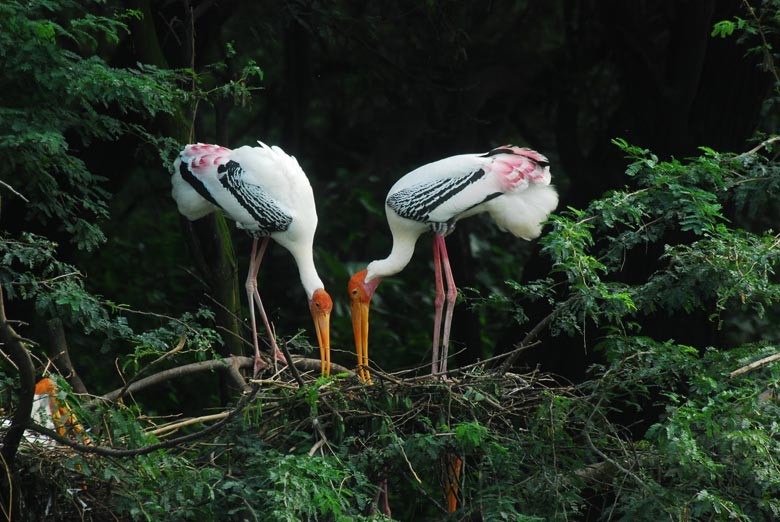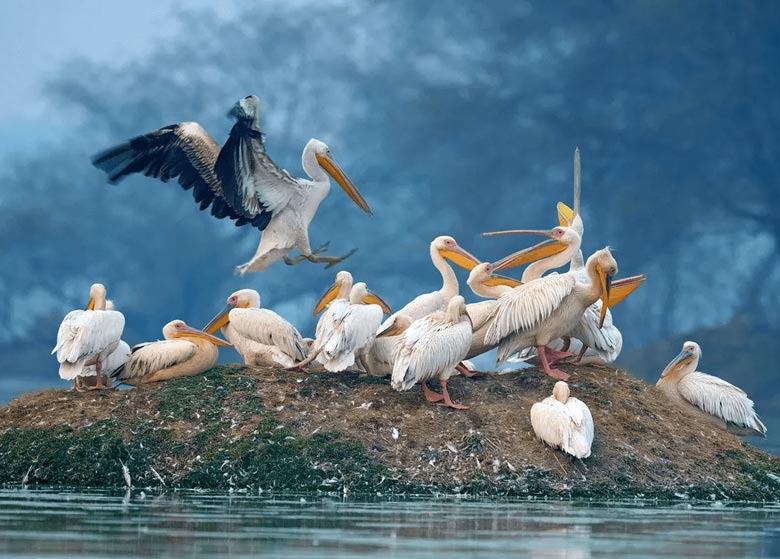Wildlife tours near Delhi
Delhi, despite being a crowded capital city, has a rich variety of birdlife and most of the commoner Indian birds are to be seen in its environs. The riverain so, tract along the Jamuna, the dry scrubland forests of the northern Ridge and the swampy marshes of the Sultanpur fir hil south of the city offer a wide range of bird habitat. According to the 1908 Imperial Gazetteer, at one time Delhi also had foxes, blackbuck, Indian gazelles, crocodiles and even leopards, but now there are only a few jackals and Nilgai left. However, the birdlife is still abundant and the green areas which of surround Delhi’s historic monuments like the Lodi tombs, Humayun’s tomb, Surajkund and the Tughlaqabad fort have a thriving population of birds. In winter the Delhi Zoo turns into a small bird sanctuary as many migratory species fly in to winter on its artificial lakes. From October to March, Pintail Ducks, Barheaded Geese and Shovellers can be seen swimming here along with the resident Spotbill Ducks and Painted Storks.
List of National Park in Delhi

National Park in Delhi
Migratory birds also come in large group to the Sultanpur lake, which is an hour’s drive from Delhi. This shallow but expansive lake has hundreds of Greylag Geese, Demoiselle Cranes and Pintail Ducks visiting it regularly every winter. There are Gadwalls, Mallards and a few Brahminy Ducks as well, floating languidly around the lake. One has to get herequite early in the morning to be able to see the birds, since many of them fly away later to feed in the fields around the lake. The reedbeds that encircle the lake shelter many resident waterbirds and their nests. There are always a few Pond Herons (Paddy Birds, as they are also known), standing here on guard and nearby Pied Kingfishers catching their fish by hovering above the water. Gliding a few feet above may be a Marsh Harrier, scanning the lake for prey. There are always many River Terns, Blackwinged Stilts and Common Sandpipers feeding here, along with groups of Spoonbills, Avocets and White Ibis. The grove of acacia trees growing in the middle of the lake sometimes hides a large Nilgai or a herd of Sambar in its shade.
Wildlife Parks near Delhi

Wildlife Parks near Delhi
Wildlife Parks near Delhi
While Sultanpur is a good place to find migratory ducks and waterbirds, the flowering trees that line the avenues of Delhi also teem with birds. The Silk Cotton, a tall tree with large scarlet flowers, will often harbour Rose-ringed Parakeets, Redvented Bulbuls, Mynas and Purple Sunbirds in its branches once it begins to flower around the end of February. The Gulmohur tree also has bright orange-red blossoms but they only appear in the burning sunshine of May to last till the end of July. The golden yellow flowers of the Indian Laburnum and the pink and white flowers of the Pink Cassia appear a few weeks before the summer starts but the fragile blossoms fade away quickly once the sun becomes too strong. The flowering trees attract many insects and butterflies, and the insect-eating birds follow in their wake. The tiny Greyheaded Flycatcher, the arrow-lake Small Green Bee-eater and the olive green, dummy White-eye all fly around the trees looking for insects. The glossy Black Drongo with its forked tail and the black-masked Rufous-backed Shrike can also often be seen hunting here. The fawn-coloured Hoopoe with zebra markings on its wings stays on the ground mostly, and digs out worms with its curved beak. Its smart crest feathers are usually kept neatly folded back and are sometimes fanned out suddenly as if the bird were surprised. The drab brownish-grey Jungle Babblers hunt on the ground too and move around the undergrowth in groups of seven or five. They are called “seven brothers” in Hindi while in English the popular name for these noisy, querulous birds is “seven sisters”. The Red-wattled Lapwing runs hurriedly to and fro on the lawns insistently calling out, “Did-you- round. do-it” as it looks for food on the ground.
The old Neem and Mango trees with their crowns of dense green foliage often have Goldenbacked Woodpeckers and Mahratta Woodpeckers scuttling up and down the tree trunks, picking out insects from the bark. The elegant Magpie Robin is a common bird that can be seen in every garden, along with the Indian Robin, as they fly around the shrubs whistling melodiously. The Koel begins to call usually when the summer season starts, and continues to do so for the next two or three months. Its cousin, the Pied-crested Cuckoo, arrives in Delhi just before the monsoon rains, and both these birds are said to dupe crows by laying eggs in the crows’ nests. The small green Coppersmith can be heard all through the summer months as it calls out in metallic, monotonous notes.
This fruit-eating bird is seen on Pipul and Banyan trees which have ripe fruits on them. The Golden Oriole, one of the most beautiful birds of India, can sometimes be glimpsed on fruit trees, but mostly stays hidden in the foliage. The Green Barbet calls out so loudly and tunelessly from the tree-tops that one has to notice it. The Tailor-bird too has a loud call, surprising coming from such a small bird. It uses its sharp beak to stitch up a leafy cover for its nest. It stars as the “Darzee” in Kipling’s famous story Riki-tiki-tavi.
The Ridge is a vast area of scrubland forest preserved right in the heart of Delhi, and this rocky terrain has more than a hundred bird species in it. There are narrow paths leading into the forest from the main Sardar Patel Road, and once inside you can follow the horse tracks which run like a maze through the acacia trees. The most common bird On the Ridge is the peacock and many large families walk around the bushes. The rocky ground is full of rodents, and the Indian Hare can be seen scampering along the dry grass.

Wildlife in Delhi
Birds or prey find this a rich hunting ground and Tawny Eagles, Black-winged Kites, kestrels and Pariah Kites can be seen scouting for prey on the Ridge. The thorny bushes of the forest have wild berries on them and the Pied Bushchat is in evidence, along with the smallest of all migratory birds, the Bluthroat. When the Flame-of-the-Forest flowers in March, its orange flowers attract nectar-feeding birds like bulbuls, parakeets and barbets. The harsh cry of the Tree-pie can be often heard on the Ridge, and the bird will glide through the trees, trailing its long black tail. The large Grey Hornbill is a resident too, and there are quite a few nests with plastered up walls in the trunks of old trees. The grasses and low bushes that cover the ground have large flocks of White-throated Munias flitting about collecting seeds, and there are usually some Red Avadavats amongst them. The acacia tree may shelter a pair of dozing Spotted Owlets. Their larger relative, the Great Horned Owl, might be found in a rocky hideout nearby. In winter many Black Redstarts come down from the mountains to live on the Ridge, and very often Scarlet Minivets fly there too.
The Ridge has an uneven terrain with many low-lying areas and crevices where water collects during the rains. Bee-eaters gather here to catch winged insects. The White-breasted Kingfisher and the Small Blue Kingfisher sit patiently on branches above the muddy pools to pick up tadpoles and insects.
During the summer months, the Ridge becomes very dry, and most birds fly into gardens nearby to drink water from hose pipes. There are large numbers of monkeys on the ridge to and they usually stay around trees like the Jamun, Pipul and Neem. The monsoon rains change the vegetation of the Ridge and for a short while the dry, brown landscape turns into a green forest. Now birdlife becomes even more varied since the rich fertile ground brings many more species to the Ridge.
For more information about Wildlife Sanctuaries and National Parks in Delhi and Delhi Sightseeing Tour by Car Contact Swan Tours, One of the leading travel agents in India.

